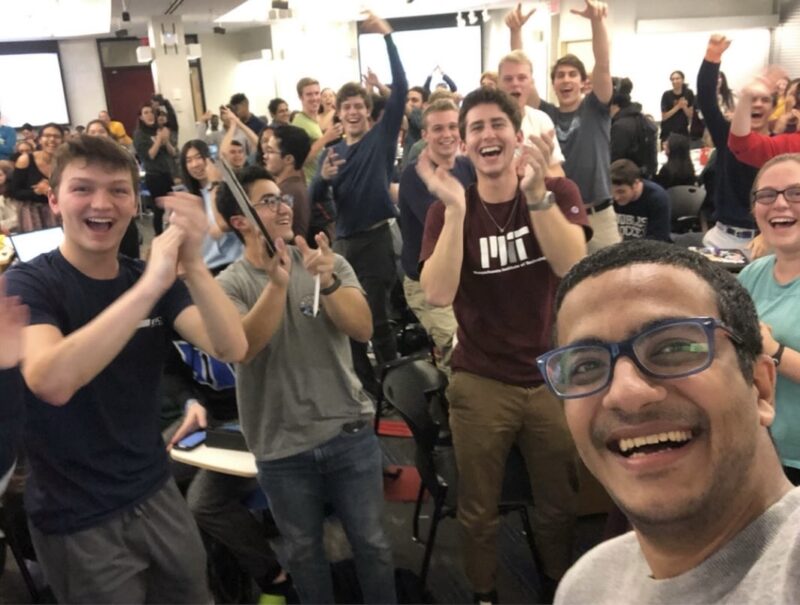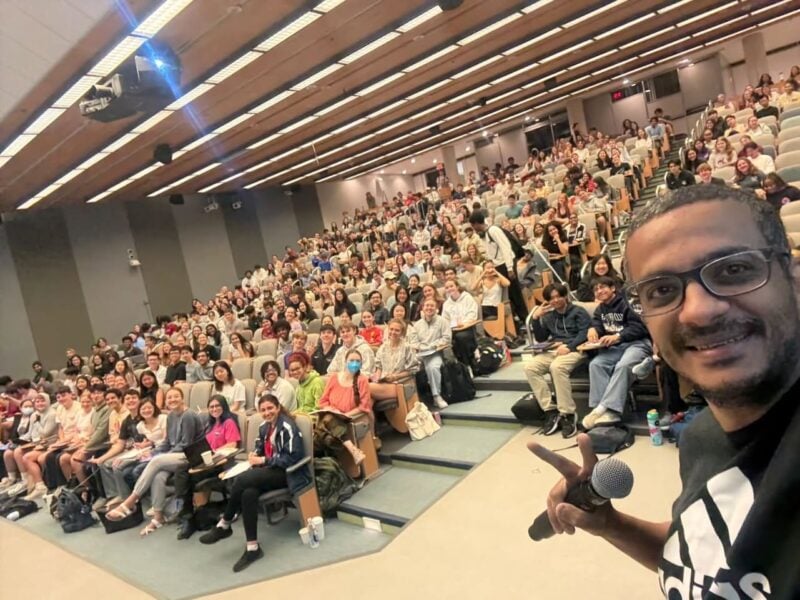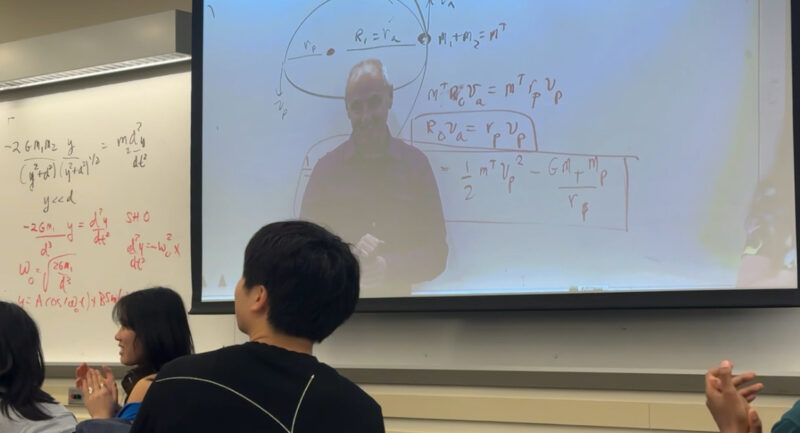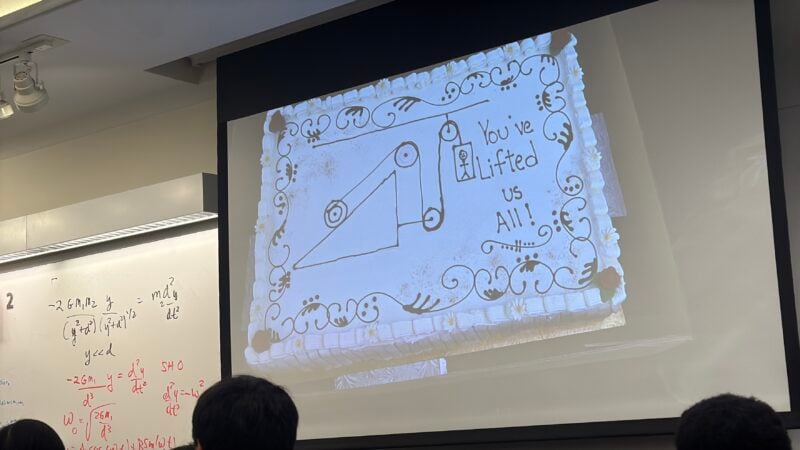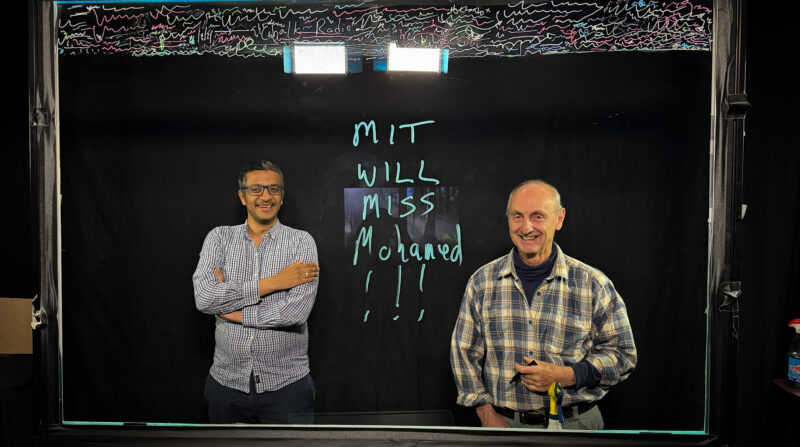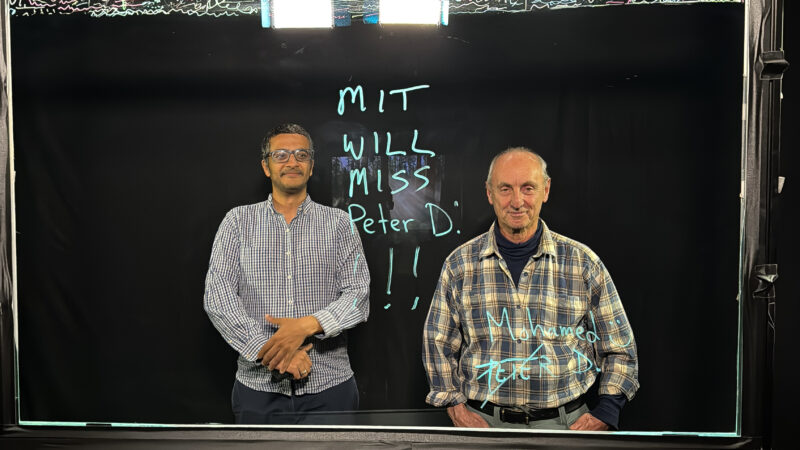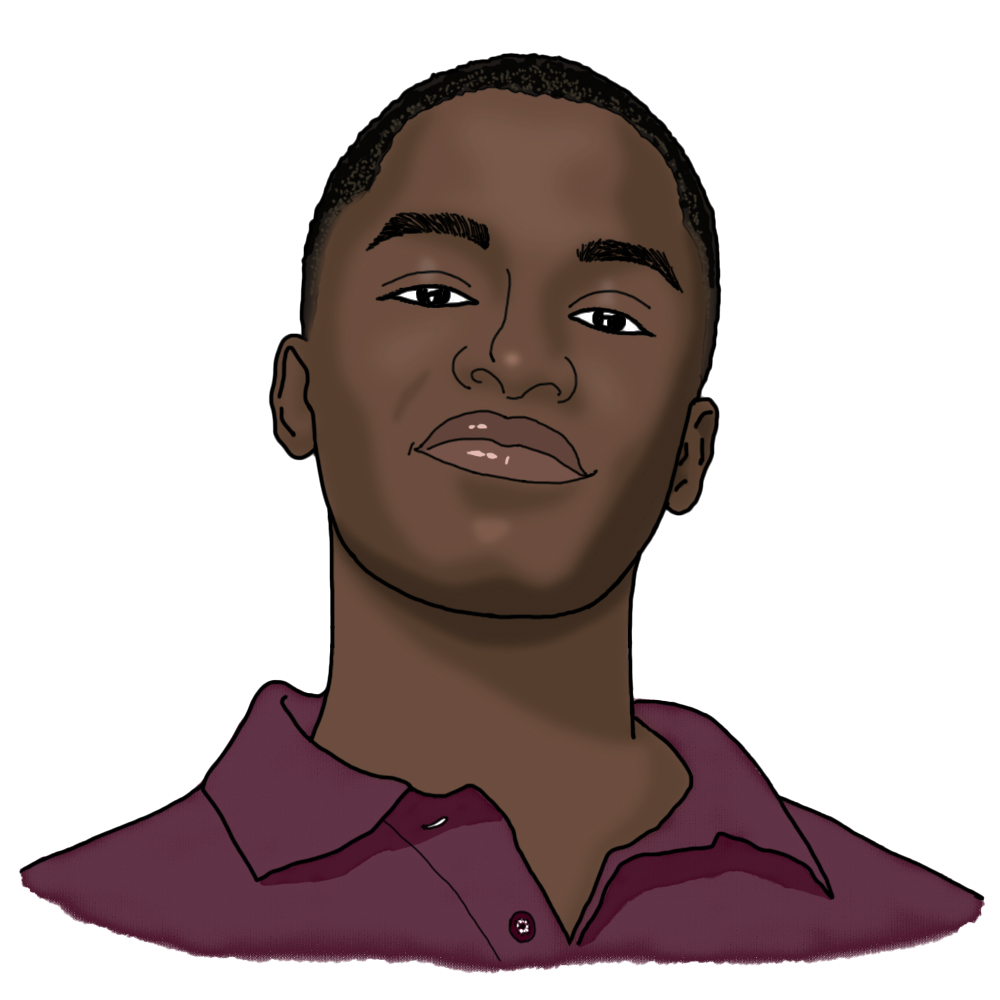
[Joint Post] Interviewing Two MIT Physics Heroes by Richard O. '28
An Interview with Two MIT Physics Professors that are Departing from MIT.
This year, MIT learned that two beloved members of our community would be leaving the institute at the end of the year. Professor Peter Dourmashkin and Lecturer Mohamed Abdelhafez are two physics teachers that have supported the education of physics at MIT in a myriad of ways. From developing the TEAL structure of the 8.01 (Classical Mechanics) and 8.02 (Electricity and Magnetism) subjects that most all MIT students take to giving up hours of their time to making sure students feel comfortable with the course material, both professors have contributed so much to the physics community here on campus and beyond.

The VIPs themselves.
So, with that, fellow blogger Kano and I decided to conduct an interview to document their stories and transcribe them in a blog so that we could highlight the kinds of people that make MIT, MIT.
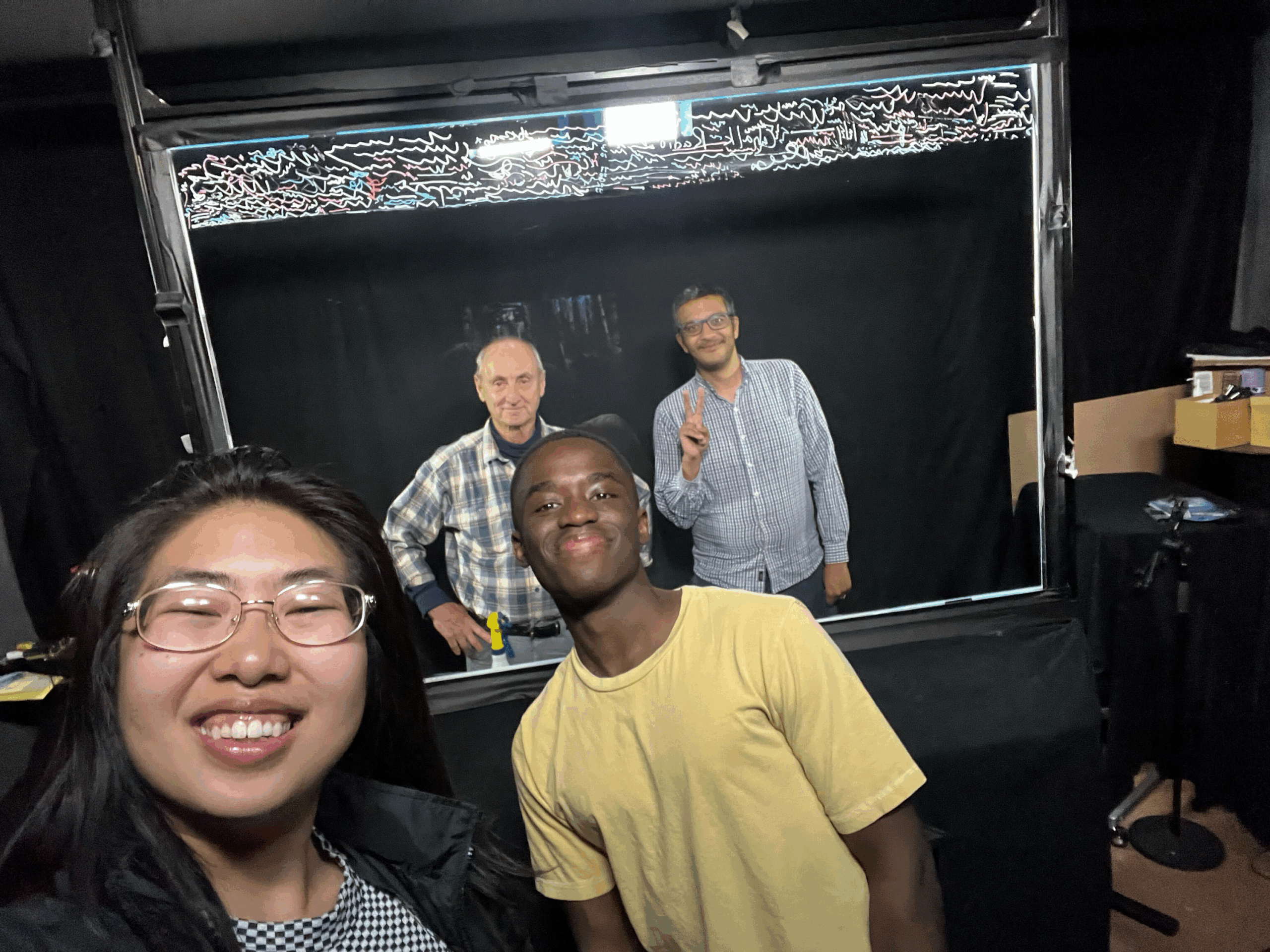
… and the interviewers in the beloved light room!
We hope this blog captures the impact that these two professors have had on our institute in their time here and provides a little glimpse into these two lives that the MIT community would not be the same without.
Note: “[…]” represents cut out pieces of the transcription for clarity and/or space saving
Introductions:
Peter Dourmashkin is a senior Lecturer who came to MIT in 1972. After attaining his PhD, Peter began working at MIT in 1984 in a number of different MIT educational initiatives ranging from the Terrascope program and Integrated studies program to Project Interphase and teaching in the Physics Department. “Eventually, the physics department said, ‘just concentrate on physics — just do that.’ So, I’ve been here a long time,” Peter said. Peter’s last day at the institute is July 31st, 2025.
Mohamed Abdelhafez is a lecturer in the physics department who has been with MIT for six years. Mohamed originally hails from Egypt where he completed his undergraduate degree and attended the University of Chicago to attain a PhD in physics. During his time at the University of Chicago, Mohamed realized he was more interested in education than research and came to MIT to pursue that passion. “I wanted to shift more into teaching and I was lucky that I got a postdoc here at MIT in physics education research,” he said. Mohamed has been teaching at MIT since 2019 and his last day will be July 1st, 2025.
MIT Experience
Following the introductions, we then asked both lecturers about their personal experiences with MIT.
When asked about what they love the most about the Institute, Mohamed replied saying there were two things: The first thing was students. “I love MIT students. I feel like there is a very special connection between me and MIT students,” he said. “Students here are very motivated and very interactive and appreciative. They shaped me into who I am, really.” The second thing that Mohamed stated was the excitement that exists on MIT’s campus. “There is always something new and exciting happening. Nothing is static here. You have to be on your toes all the time and listen to new ideas.”
In Peter’s response, Peter discussed the value he finds in being able to make an impact in the lives of the students he teaches. “When I go elsewhere, people ask me: ‘what do I do?’ […] I just basically say it’s an incredible privilege to teach at MIT because we do have some of the best students in the United States,” Peter said. Peter then went on to describe a story of an encounter he had with a previous student of his who had told him and his wife that Peter had helped him pass his 8.01 course which allowed him to become a computer science major. “And that’s just really satisfying. It has just really been a privilege. I consider myself incredibly lucky that I managed to stay here for this long,” he added.
We then asked the two about their first impression of MIT when they arrived.
Peter explained how he had initially been shocked with the environment upon arrival, not having originally been from a city, but then started to find people who made his experience more interesting. “So it was a transition period. Over time, you meet so many interesting people, it’s amazing,” Peter said.
Mohamed then followed by explaining how, when he first came, he had fears of not being able to adequately support the students. “I was very scared that I didn’t have the necessary background to teach those kids,” Mohamed said. He then went on to explain how, very quickly, he realized that just like any other student, MIT students can struggle in physics classes too. “MIT students are very special and each of them in their own different way, but not all of them were finding physics, for example, very easy. On the contrary, I would say the majority actually have some struggles with physics and math – just like anywhere else,” Mohamed said.
Teaching Physics:
Zooming into their experiences on campus, we then wanted to focus on their experience in the classroom by asking them about their favorite memory from teaching physics.
Mohamed started by explaining his experience leading to his first few exam review sessions while working as a graduate TA (Teaching Assistant) under Peter. Peter added, “I remember Mohamed and I did it together. I remember just saying, okay, Mohamed, now you do this.” Mohamed then explained how he felt pretty nervous before the first review but then reassured himself that he had done the best he could to help the students when the review was over. For the second review session, however, Mohamed described his shock when he was welcomed by a hallway packed with almost 200 students. “I didn’t really believe that this was happening. I think that right there, I told them: ‘I think this will be my peak.’ […] But wow, there were maybe 200 students all thinking that this is helping them. So yeah, I always remember that night.”
Peter then answered by describing moments where students would work out problems on their own in the classroom and he could walk around and have conversations with them. “That type of connection is the feeling that it’s not a lecture, it’s a learning community, and that’s really special.” Peter then discusses how he really enjoys the moments where he sees a student is struggling and is able to say something that changes the way they approach the problem that leads to those ‘aha’ moments. “All those things, they just add up,” he said.
After this, we shifted to a discussion about physics as a subject and asked the two what their favorite concepts/topics were from 8.01 and 8.02.
Peter answered with, “rotation translation of rigid bodies from 8.01” and described a class demo that’s usually done using a bicycle wheel that’s spun and then allowed to skid and roll along the floor. “We do a special case of it, with a fixed axis, but it generalizes to some really elegant and beautiful mathematics at the same time,” Peter said. He then added that Faraday’s law was his favorite from 8.02 because it has the most demonstrations and is the most historically misunderstood.
Mohamed followed by explaining his appreciation for the abstraction that comes with 8.02, especially with Gauss’s law, having been a theoretical physicist and having a deep interest in mathematics. “Gauss’s law is a big mathematical abstract idea. You have to construct imaginary surfaces and stuff. So I love the first layer of abstraction that comes with Gauss’s law,” he said. Mohamed then added that Faraday’s law and the assembling of Maxwell’s equations were also his favorite because they provided an, “elegant way of describing the whole course.”
From here, we went on to ask how they had felt the teaching of Physics has changed in their time at MIT.
Mohamed explained how the implementation of learning sequences, which are online modules with videos and questions to introduce students to new topics before lecture, has improved since his arrival to campus. “I think that model has been refined year by year by Peter and other members in the group and I think now we have a better model than we had before,” Mohamed said.
Peter then answered by explaining how the entire TEAL (Technology Enabled Active Learning) format of the physics courses had started and been improved gradually during his time at MIT. The format of TEAL, according to Peter, was based on several different teaching models across different universities, and, over time, saw improvements such as the introduction of undergraduate TAs to bridge the gap between students and staff as well as the lightboard that’s used in the learning sequence videos. “So when you ask how the course changed, there were a hundred little changes like that since the very beginning,” Peter stated.

Example of a learning sequence video on MITx using the lightboard
After hearing about all the thoughtfulness that went into the decisions made for the course, we then wanted to know if either of the lecturers had a favorite physics joke.
Peter replied describing a moment he has with students where they’re working with objects on an inclined plane. During this unit, sometimes Peter would usually approach a group of students and ask them which cylinder they feel will reach the bottom of the incline first. Knowing that the students would often know the correct answer and choose that one, he then holds the two cylinder at the top but then releases the one that they didn’t choose ahead of the other cylinder so that it reaches the bottom first while holding the cylinder they did choose. “So sometimes I’ll intentionally say things that aren’t right, because you have to break out of that mindset. You have to think independently and challenge everything that people say and decide whether it’s true for yourself. So sometimes I like to shake up the class that way, and that’s always fun. I love that,” Peter said.
Hearing this enjoyable moment, we then followed up with a question asking how the two would describe their relationship with the student body.
Mohamed started by describing the feeling as magic. He explained how he struggled to understand the immense appreciation that’s been shown to him from students and how whenever a new cohort of students starts taking the physics GIR’s (General Institute Requirements) they immediately develop a sort of trust in him. “There is a huge trust in me, and I trust them. I really value this mutual trust,” Mohamed said.
Peter followed by emphasizing the trust students have in Mohamed, stating how Mohamed’s work is usually done for the students in a selfless way. “He’s there to help the students learn. He’s not there maybe to show how smart he is or how much he knows and that’s immediately obvious and you can see that with personal interactions with people,” Peter said. Peter also added a comment describing his appreciation for Mohamed’s fast response time on the platform Piazza which is a tool that students can use to submit public or private questions to course staff about homework or course material. “When students ask Piazza questions, sometimes I’m sitting there and I see it. I’m getting ready to write an answer, but Mohamed’s already answered!”
Peter then explained how spending so much time at the institute has changed his interaction with the students from when he was only a few years older than them to being much older than them. Looking ahead, however, he expressed excitement for the future of the current physics education group. “At this stage in my career, I consider it a huge accomplishment that the physics department has made a commitment to education,” he stated.
We then went on to ask a question for the blogger audience not on MIT campus that would hope to take a physics class at MIT one day and asked if the lecturers had any advice for these students.
Peter began by highlighting the importance of keeping a positive mindset. Having been an undergraduate at MIT himself, Peter explained how coming to MIT for the first time can make it really easy to experience imposter syndrome, but then explained how having the right framework of mind can make one’s time here all the more exciting. Peter then emphasized the numerous resources available for students in 8.01 and 8.02. “Everybody is an MIT student, and each person will realize their own potential. And so you don’t have to compare yourselves to other people. You just want to have a really positive attitude. Then when you graduate, you realize, ‘Wait a second, how did it go so fast?,’” Peter said.

Diagram demonstrating how physics is ACTUALLY taught at MIT. (Image courtesy of our very own Jebby!)
Mohamed seconded everything Peter had said while urging the importance of getting stuck on a problem and not being hesitant to ask for help. In describing the learning process, Mohamed states that, “it’s okay to be stuck and spend some time on a problem and then ask for some help. Take your time to be stuck and to struggle a little bit, and that helps you. Without that, you’re not going to grow.”
Personal Life and Looking Ahead
In this section we wanted to learn a little more about the personal aspects of their lives and we began by asking if the two had any hobbies outside of physics.
Peter started by explaining how he had to postpone a number of activities since he began teaching physics. “We wrote a book on the physics of bicycling, but now I have to update it to eBikes and motors because we wrote it in the early eighties,” Peter said. Peter also added that he was really interested in the intersection of mathematics and music and he plans to continue playing the piano and pursuing his music passion by taking music theory courses.
Mohamed followed by sharing his deep love for Arabic music. “I want to start a YouTube channel or something for the Arabic audience.” Additionally, Mohamed is a big fan of soccer and stated that he enjoys following the English Premier League but also added that he has a third passion for programming where he often uses programming in the context of his other two passions. “So I’ve written code for music that I’m playing on my own keyboard. And I also have written code for soccer for the Premier League. I’m a very big fan of just putting my brain into something that can help people, especially in the places where I’m passionate about.”
During this discussion of programming, Peter also pointed out that in his time at the Institute, Mohamed has had a significant hand in developing code that has helped to improve the organization needed in the backend of the physics courses. “Mohamed’s written a huge amount of code that has totally simplified my life and saved hours and hours and hours in terms of the backend of the course,” Peter stated.
Building off the idea of passions and hobbies, we then asked how the two would unwind after a long day of working at MIT.
Peter listed several activities that included walking, talking, and cooking with his wife, playing the piano, taking care of his cat, as well as tending to a garden. “I might put an hour in the garden every day. It’s very meditative to get the soil in your hands and I like that a lot,” Peter said.
Mohamed then told us about his two daughters and how he would spend time with them after picking them up from school and then begin working after they fell asleep. With his two daughters getting older, he also noted that he found himself having more free time which has allowed him to spend more time learning how to play Egyptian music. “Any time I have now at home, I’m just trying to recreate any of my favorite songs from memory and then I post it on Instagram,” Mohamed said.
We then asked both lecturers what career they think they would’ve pursued in an alternate universe where they didn’t take on physics.
Peter answered by telling us that he had first come to MIT wanting to be a film major because of a film documentary program on campus, but, for a time, he had considered transferring to the California Institute of the Arts. He then told us a story about when he visited the school and met a film specialist (who turned out to be the creator of Star Wars) but then added that he was happy having stuck with physics because he felt he might’ve burnt out working in film.”So my alternative life might’ve been in film, but I’m happy that I didn’t do that,” Peter said.
Mohamed then told us he either would’ve been a web developer or a musician and shared a story about his experience in writing songs for the scouting team at his University in Egypt where people would sing the songs he wrote. “I’m actually recovering my songs that I created and now I can play them. It’s magnificent for me,” Mohamed added.
To finish off the interview we then asked both lecturers what they were most looking forward to when looking ahead.
Peter started by stating a number of upcoming experiences that include his daughter having her second child in September, spending more time exploring music, sports, and painting, volunteering for indigenous groups, travelling, spending time with his wife, and living. He then added that he would especially miss working with Mohamed for the past six years where he had the opportunity to learn from him. “There’s this very subtle process about ending your career, because sometimes people look through you and every transition in life always has its surprises and its difficulties and its positive things. So I’m kind of looking forward to embracing that transition,” Peter said.
Mohamed then replied by saying he was grateful to have been able to work with Peter during his time here. “Peter has been my godfather really since I came here. And I’ve really enjoyed and will continue to enjoy our relationship, of course,” he said. Mohamed then discussed his excitement for continuing research at his alma mater, the University of Chicago. “I know that department, I know the students, I know the courses, but I was a grad student then. So it’s kind of exciting now to come back and be the actual professor teaching the course,” he added.
Following this, Peter began telling us about his first encounter with Mohamed. At MIT and many other institutions, individuals planning to work as a postdoc must give a lecture discussing the concepts they know. When Mohamed had given his lecture, Peter had been invited to sit in the audience and was astounded by the breadth of information that Mohamed had been able to demonstrate. “I was just there thinking: ‘This guy really knows what he’s talking about.’ And he’s designed his own pedagogy and model for teaching. I had the feeling too that Mohamed’s model came from actually working with students,” Peter said.
Mohamed responded by thanking Peter stating that, “Peter was very generous with me. He immediately invited me to be his grad TA in the classroom. That’s not typical for a postdoc,” said Mohamed. Mohamed then went on to add that he had learned so much about teaching introductory physics content from working with Peter. “He just invited me to work with him in the classroom. And I learned 8.01 from him,” Mohamed said.
“See that’s a great thing: teaching is about learning. And that’s the thing about MIT. I realized that you can always be a learner here, always,” Peter said.
